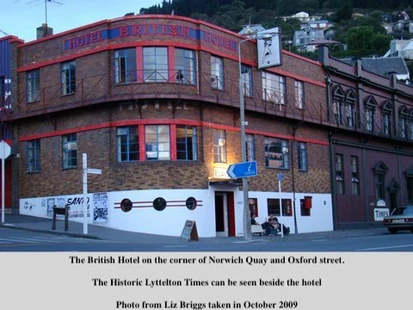N) Norwich Quay
Continue your walk straight down Canterbury Street to the corner with Norwich Quay.
Norwich Quay is the main access way to the port and was a place of hustle and bustle for seafarers passing through. Prior to the earthquakes, 5 hotels graced the street of Norwich Quay: The Royal Hotel, The Lyttelton Hotel, The Canterbury Hotel, The Mitre, and The British Hotel.
Sadly, the British is the only one of these historic hotel buildings still standing which you will pass at the other end of Norwich Quay on the corner with Oxford Street. No longer used as a hotel, it is currently utilised by local businesses.
The 2nd photo looks towards you and shows Norwich Quay before 1900, after many of the wooden buildings were replaced by concrete following the great fire of 1870. Turn left onto Norwich Quay and as you walk along the street today you will be struck by how few buildings remain after the devastating earthquake, and you can only imagine the grandeur of the buildings that once stood proud here.
On the positive …Look up towards the hills to the east and you will see the tower of the restored historic Timeball Station, a working Timeball that drops at 1pm every day. Ask at the Information Centre for the best route to visit it and a bit of its history.
Your walk will bring you to the Lyttelton Seafarers Centre at no 18, on your left. Today, seafarers from around the world are supported here through a variety of services that are vitally important to a busy, working international Port.
As Lyttelton rebuilt over the decades some of the later builds caused much controversy and division. One of those was Shadbolt House which was built in 1959 and was the only high rise in Lyttelton. Boasting 7 floors it dominated the skyline. The Lyttelton Port Company added to the mix with their concrete four storey structure in 1987.
The consequence is that Lyttelton has become home to a variety of architectural styles and building materials, and it is said that every architectural style through history can be found in this one town. These buildings have all contributed to Lyttelton being awarded Category 1 Historic Area status.
Go to the next building Electric Telegraph Office







